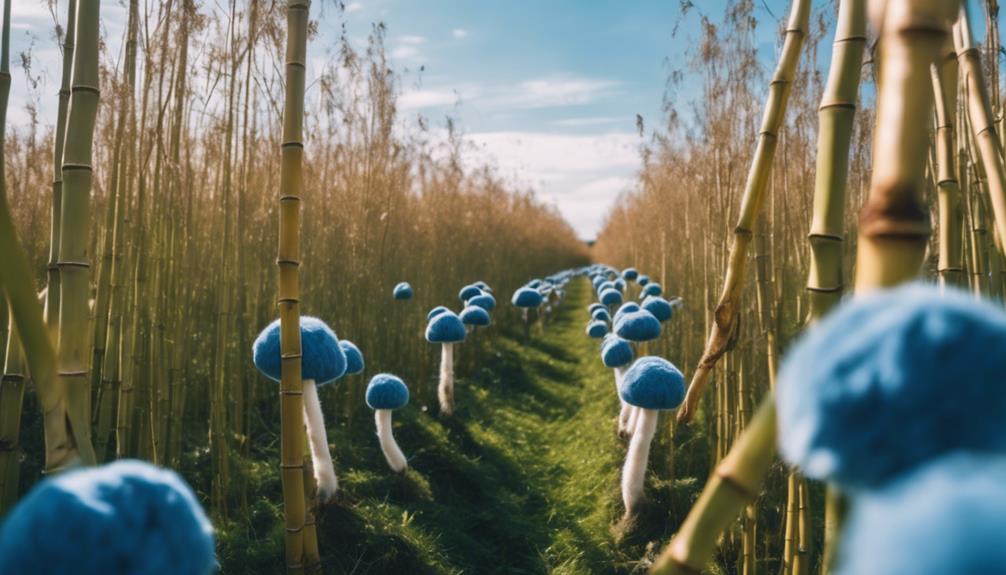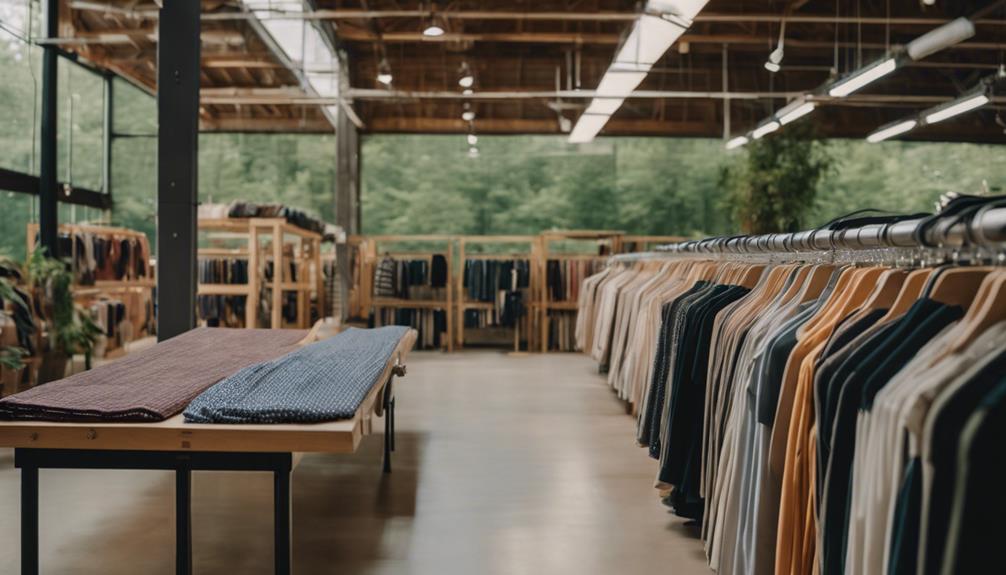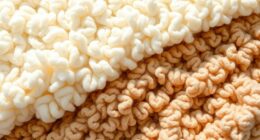Sustainable fashion materials are revolutionizing the industry, providing eco-friendly alternatives that have a significant impact on the environment. Organic cotton, for example, requires 91% less water and is free from harmful chemicals. Cutting-edge innovations like Circulose and NuCycl turn textile waste into fashionable fabrics, while bio-synthetic materials like Kintra’s yarns are completely biodegradable. Additionally, plant-based leather substitutes made from mushrooms and pineapple leaves are becoming increasingly popular. By selecting these sustainable materials, you are helping to support a healthier planet and a circular economy. Stay tuned to learn more about the promising future of sustainable fashion! The sustainable fashion impact on the environment is profound. By utilizing eco-friendly materials, fashion brands can decrease their carbon footprint and contribute to the preservation of natural resources. Moreover, the use of sustainable materials inspires consumers to make mindful decisions, prompting a shift in industry practices towards more responsible and ethical production methods. Ultimately, embracing sustainable fashion materials is a critical step towards a more eco-friendly and sustainable future for the fashion sector.
Key Takeaways
- Sustainable fashion materials are eco-friendly options designed to minimize environmental impact and promote sustainability in the textile industry.
- Popular types include organic cotton, recycled polyester, and innovative fabrics like Circulose, crafted from textile waste.
- These materials significantly reduce water usage, pollution, and carbon emissions compared to conventional textiles.
- Innovations such as bio-synthetic yarns and plant-based alternatives to leather are paving the way for more sustainable options.
Defining Sustainable Fashion Materials
Sustainable fashion materials are eco-friendly options designed to minimize environmental impact, like organic cotton that uses 91% less water than conventional cotton. These materials come from renewable sources and are produced through methods that reduce waste and energy consumption.
For instance, innovative fabrics like Circulose and NuCycl are crafted from textile waste, effectively diverting it from landfills and lowering carbon emissions compared to new viscose production.
You'll also find bio-synthetic materials, such as Kintra's yarns made from corn or wheat-derived sugar. These fibers are fully biodegradable, offering a viable alternative to traditional synthetic fibers like polyester and nylon, which can take centuries to decompose.
Additionally, sustainable fashion includes alternatives to leather, like Econyl, which is recycled nylon sourced from ocean waste, and Mylo, a leather substitute made from mushrooms.
Lastly, consider carbon-negative fabrics that convert carbon emissions into textiles. These innovative materials not only support climate action but also showcase the potential of sustainable fashion to revolutionize the industry.
Benefits of Using Sustainable Materials

Choosing eco-friendly materials not only reduces environmental impact but also enhances your brand's appeal in a market increasingly driven by consumer demand for sustainability. By opting for sustainable materials, you considerably lower water consumption and pollution; for instance, organic cotton uses 91% less water than its conventional counterpart.
Utilizing recycled fabrics like Circulose can slash carbon emissions by up to 60%, promoting a circular economy that resonates with conscious consumers. Moreover, bio-synthetic materials derived from natural sources like corn or wheat offer a fully biodegradable and renewable alternative to traditional synthetics, ensuring your brand aligns with eco-friendly principles.
Sustainable leather alternatives, such as Mylo and Econyl, reduce reliance on animal products while minimizing environmental degradation, appealing to ethically minded shoppers. Transitioning to sustainable materials can also boost your brand's reputation.
Research shows that 66% of global consumers are willing to pay more for products made from sustainable materials, reflecting a growing commitment to environmental responsibility. By making this shift, you not only contribute to a healthier planet but also build consumer trust, setting your brand apart in a competitive marketplace.
Popular Sustainable Fabric Types

When you explore popular sustainable fabric types, you'll find organic cotton and recycled polyester stand out for their eco-friendly benefits.
Organic cotton is grown without harmful chemicals, making it safer for both the environment and your skin.
Meanwhile, recycled polyester helps reduce waste by transforming plastic bottles into stylish, durable textiles.
Organic Cotton Benefits
Organic cotton offers numerous benefits, making it an eco-friendly alternative to conventional cotton. By choosing organic cotton, you're not just supporting sustainable fashion materials; you're also contributing to healthier ecosystems and communities.
Here are some key advantages:
- Less Water Usage: Organic cotton typically uses 91% less water than its conventional counterpart, which is essential in water-scarce regions.
- Reduced Chemical Exposure: It's grown without synthetic pesticides or fertilizers, minimizing soil and water contamination and protecting biodiversity.
Recycled Polyester Advantages
Recycled polyester offers significant environmental benefits by transforming post-consumer plastic waste into fashionable and functional fabrics. By using recycled polyester, you're actively participating in reducing landfill waste and minimizing the carbon footprint associated with fabric production. In fact, this innovative material can cut carbon emissions by up to 75% compared to traditional polyester.
One of the standout advantages of recycled polyester is its lower resource consumption. It requires about 50% less energy and water during production, making it a smarter choice for eco-conscious consumers like you. Additionally, when you choose recycled polyester, you're supporting a circular economy that repurposes plastic waste instead of relying on new raw materials.
As more brands adopt recycled polyester, they help decrease the fashion industry's dependence on petroleum-based materials. As of 2020, around 12.5% of the global fashion market committed to using recycled materials, indicating a promising shift towards sustainability.
Innovations in Eco-Friendly Textiles
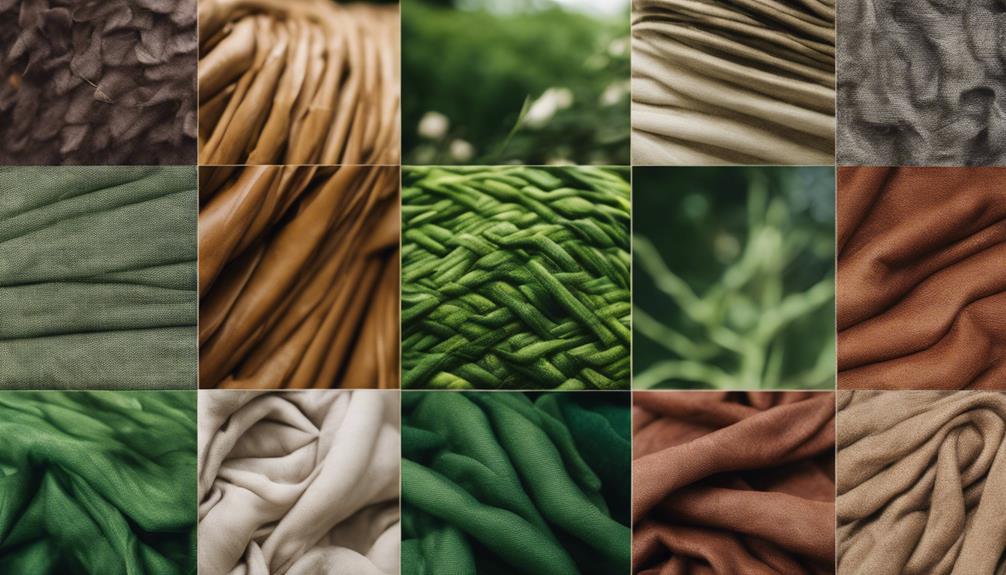
Innovative eco-friendly textiles are transforming the fashion industry by utilizing waste materials and renewable resources to create sustainable alternatives. These innovations in sustainable fashion materials not only reduce the environmental impact but also showcase the potential of creative solutions in addressing climate change.
Here are some remarkable examples:
- Circulose and NuCycl: Made from textile waste, they greatly cut down carbon emissions compared to traditional viscose production.
- Kintra's bio-synthetic yarns: Derived from corn or wheat-based sugar, these yarns are fully biodegradable and mimic the performance of conventional polyester and nylon.
These advancements not only highlight the industry's shift towards more responsible practices but also encourage you to reflect on the choices you make in your wardrobe.
The Role of Recycled Materials

The fashion industry's embrace of recycled materials is a game-changer, drastically reducing waste and lowering carbon emissions in the process. By utilizing materials like recycled polyester, made from plastic bottles, brands can cut energy usage by up to 59% compared to creating virgin polyester.
Despite the potential impact, only about 15% of consumers recycle used clothing, while the industry discards a staggering 92 million tons of textile waste each year.
Brands such as Patagonia have led the charge in incorporating recycled materials, helping to create a circular economy and lessening the need for new raw materials. When you choose products made from recycled materials, you're not just making a fashion statement—you're actively preventing millions of tons of plastic from polluting our oceans and landfills.
As the demand for sustainable options grows, investing in recycled materials is a smart move for brands aiming to meet their sustainability goals. The market for recycled fibers is projected to expand at a compound annual growth rate of 12.5% from 2021 to 2028, showcasing the increasing importance of recycled materials in shaping a more sustainable fashion future.
Plant-Based Alternatives to Leather
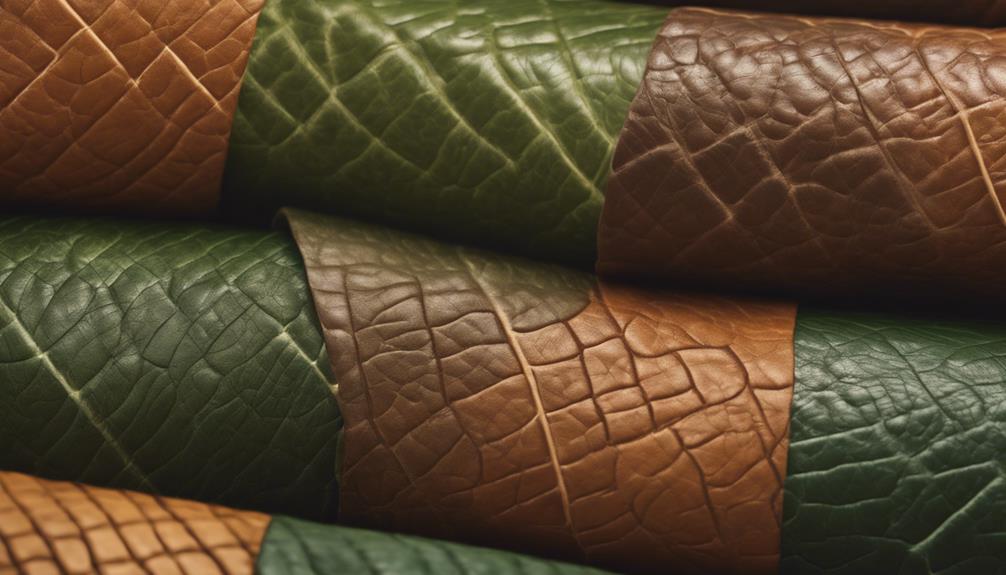
As consumers seek more sustainable options, plant-based leather alternatives are emerging as viable solutions that reduce reliance on animal products and minimize environmental impact.
These innovative materials not only offer stylish choices but also promote a more ethical approach to fashion.
Here are some exciting plant-based alternatives to leather you should know about:
- Mylo: Made from mushroom mycelium, it's a renewable option with a lower environmental footprint.
- Pinatex: Derived from pineapple leaf fibers, it utilizes agricultural waste, turning what would be discarded into a sustainable resource.
Other notable options include Desserto cactus leather, which is resilient and uses less water, and Qmilch fabric, crafted from milk protein and biodegradable.
By choosing these plant-based alternatives to leather, you're not just making a fashion statement; you're also supporting sustainability and reducing waste.
Embracing these materials allows you to enjoy stylish products while making a positive impact on the planet.
Challenges in Sustainable Material Sourcing
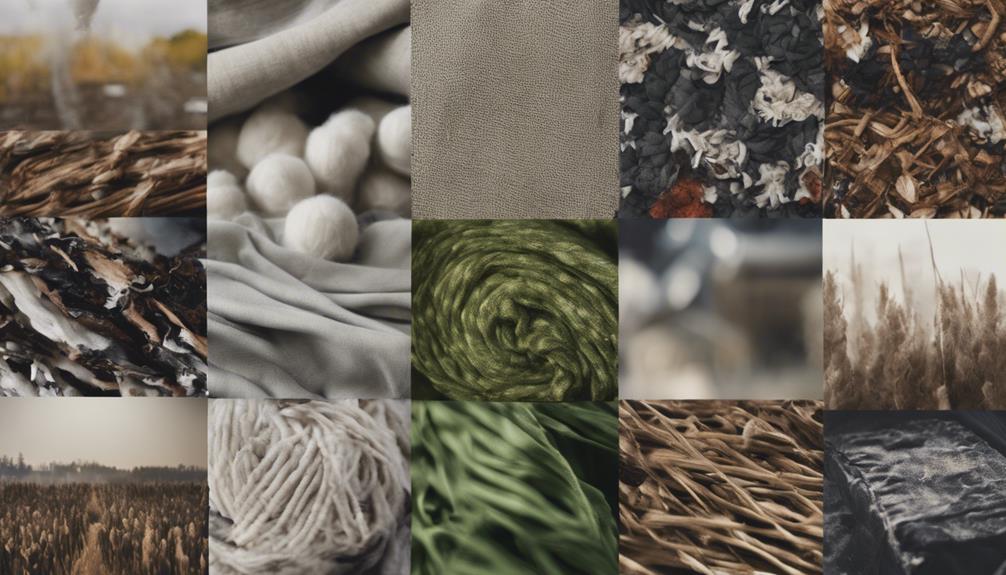
When you consider sourcing sustainable materials, you're likely to encounter challenges like limited availability and high production costs.
These issues not only affect your budget but also impact the overall environmental footprint of your materials.
Understanding these hurdles is essential as you navigate the complexities of sustainable fashion.
Limited Availability of Materials
Limited availability of sustainable materials poses a significant challenge for brands endeavoring to meet the growing consumer demand for eco-friendly fashion. The slow production processes and high costs associated with eco-friendly sourcing make these materials less accessible than conventional options. As you navigate this landscape, it's crucial to recognize the following hurdles:
- Limited Supply: Only a small fraction (less than 1%) of global textile production consists of recycled materials, restricting your sourcing choices.
- Production Shifts: The change to materials like organic cotton or recycled fabrics requires significant agricultural and manufacturing changes, limiting scalability.
With consumer interest in sustainable fashion skyrocketing, the current supply chain infrastructure struggles to catch up. Understanding these challenges can help you appreciate the efforts brands make in sourcing sustainable materials.
High Production Costs
How can brands justify the high production costs associated with sustainable materials while trying to meet consumer expectations for eco-friendly fashion? The truth is, sustainable materials often come with a premium price tag. For example, organic cotton can be 20-30% more expensive than conventional cotton due to the need for natural farming practices and certification. This can discourage brands from making the switch.
Moreover, the limited availability of sustainable raw materials, like recycled fibers or biodegradable alternatives, complicates sourcing and drives up costs. You might notice that brands struggle to scale their sustainable practices, as the infrastructure for producing and processing these eco-friendly materials isn't as developed as that for traditional textiles.
Consumer reluctance to pay higher prices also creates a financial barrier. While you may be passionate about sustainable fashion, many consumers still hesitate to invest in pricier items.
Consequently, brands face a challenging balancing act: they want to promote sustainability, but they also need to meet consumer expectations without alienating their customer base. This dilemma makes the journey toward sustainable fashion more complex than it seems.
Environmental Impact of Sourcing
While brands wrestle with high production costs, the environmental impact of sourcing sustainable materials presents its own set of challenges that can complicate their efforts. Even when aiming for sustainable fashion, you might encounter significant hurdles, such as:
- High water usage: Conventional cotton production can consume approximately 1,800 gallons of water for just one pair of jeans.
- Chemical risks: The textile industry employs around 8,000 synthetic chemicals, with only 16 approved by the EPA, raising serious environmental concerns.
Even innovative materials like Circulose and NuCycl, made from textile waste, still use water-based chemical processes that carry environmental risks.
Additionally, bio-synthetic materials, while promising, often depend on agricultural inputs that can lead to land degradation and resource competition.
These complexities make it clear that the journey toward sustainable fashion involves traversing a minefield of challenges, all while trying to create a more eco-friendly future.
Future Trends in Sustainable Fabrics

Future trends in sustainable fabrics are transforming the fashion industry by introducing innovative materials that prioritize environmental impact and resource efficiency.
You'll notice an exciting shift towards bio-synthetic materials like Kintra's yarns, derived from corn and wheat, which are fully biodegradable and renewable. Innovations such as Circulose and NuCycl are revolutionizing how we view textile waste, turning it into valuable sustainable fabrics that remarkably cut carbon emissions compared to traditional viscose.
Additionally, the emergence of carbon-negative fabrics like AirCarbon showcases how we can convert CO2 emissions into textiles, contributing positively to climate action.
You'll see sustainable leather alternatives gaining popularity too, such as Econyl, made from recycled ocean waste, and Mylo, created from mushrooms, offering eco-friendly options that don't compromise on style.
Moreover, the exploration of fruit-based and dairy fabrics, like Piñatex from pineapple fibers and Qmilch from milk protein, reflects the growing diversity in sustainable material sources.
These advancements not only highlight the creativity within the industry but also emphasize a collective movement towards a more sustainable future in fashion.
Get ready to embrace these changes!
How Consumers Can Support Sustainability

You can make a significant impact on sustainability in fashion by choosing thrift and consignment stores for your clothing purchases. By opting for second-hand items, you not only extend the lifecycle of clothing but also help reduce landfill waste.
Here are a few simple ways to support sustainable fashion:
- Research Ethical Brands: Look for brands that prioritize sustainability and ethical practices. They represent about 12.5% of the global fashion market committed to positive change.
- Participate in Clothing Swaps: Engage with your community by swapping clothes. This reduces individual consumption and promotes sustainability while tackling the fashion waste crisis projected to reach 148 million tons by 2030.
Frequently Asked Questions
What Is Sustainable Material in Fashion?
Sustainable materials in fashion focus on eco-friendly options that minimize environmental impact. You can choose organic cotton, recycled textiles, or innovative bio-synthetic fabrics, which promote health and sustainability while reducing waste and resource consumption.
What Is the Problem With Sustainable Fashion?
You'll find that the problem with sustainable fashion lies in widespread greenwashing. Many brands mislead consumers, claiming eco-friendliness while contributing to pollution and waste. This confusion hampers your ability to choose genuinely sustainable products.
What Are Examples of Sustainable Fabrics?
Imagine dressing in the clouds of sustainability. You've got Circulose, Econyl, Mylo, and Piatex—all weaving a new narrative in fashion. Each fabric spins a story of waste reduction, eco-friendliness, and a brighter future.
What Is the Paradox of Sustainable Fashion?
The paradox of sustainable fashion means you're often misled. While brands claim eco-friendliness, most still rely on harmful materials. This contradiction creates confusion and highlights the industry's slow progress towards genuine sustainability despite rising consumer demand.
Conclusion
In a world where fast fashion reigns supreme, embracing sustainable materials isn't just a trend; it's a revolution.
By opting for eco-friendly fabrics, you're not just dressing yourself; you're making a statement for the planet.
Remember, every choice you make counts—like a knight in shining armor fighting against waste!
So, support brands that prioritize sustainability, and let's pave the way for a greener future together.
Your wardrobe can be both stylish and responsible!
